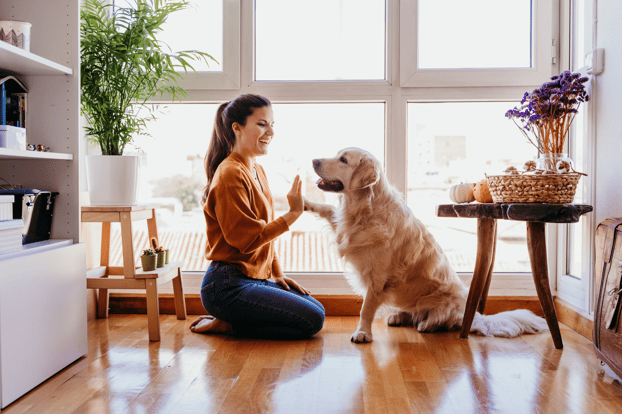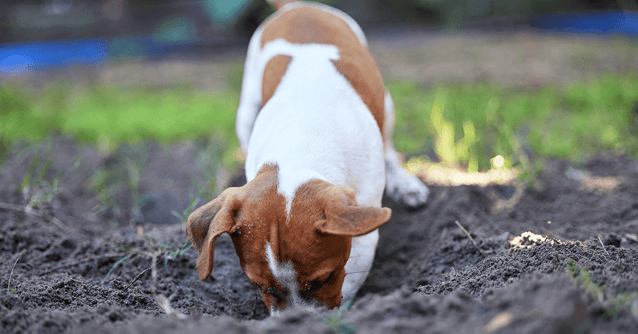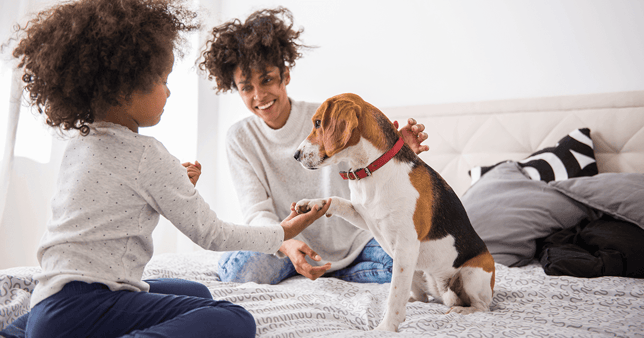From adventurous hobbies to ill-fated exercise regimes, the new year is truly a time of fresh opportunities. But while some of these resolutions may be more successful than others (we’ll run a marathon next year, we promise), the new year can also bring new additions to the family. If you’re thinking of adopting a dog this year or have recently brought home a new puppy, congratulations! This is an exciting journey filled with wagging tails and bonding moments. That being said, there’s a lot to consider when it comes to creating a dog-friendly home. Keep reading for our experts’ tips on dog-proofing your home this new year.
Understanding Your New Dog’s Needs
First things first, when adopting a puppy or dog, it’s essential to gain a full understanding of their needs. Speak to the breeder or rescue centre staff as they can provide valuable information regarding any special routines your new dog is accustomed to. For instance, rescue dogs may be used to having things a certain way, and breaking from those routines may cause the settling-in process to become a source of stress or anxiety. Instead, we can initially emulate those routines before gradually transitioning them to fit your family’s schedule.

The Basics Of Dog-Proofing Your Home
Dogs are curious creatures, and puppies especially! They tend to explore with their mouths, meaning that anything from your favourite shoes to everyday household objects might be at risk. As well as potentially leading to breakages, this can actually be harmful to your new dog, too. Some objects can be hazardous to swallow or can lead to choking. With that in mind, here are some puppy-proofing tips to prepare your home for your new family member:
- Hide the Hazards – Before adopting a dog or puppy, ensure that any cleaning items and hazardous human foods like chocolate, raisins, and onions are out of paws reach. Baby gates or stairgates can be effective for blocking small spaces or rooms where potential dangers lurk.
- Cable Management – Try to keep cables out of reach as much as possible. If this isn’t suitable, consider using cable covers instead. Similarly, don’t forget to tie up curtain cords or blind strings to avoid any unexpected accidents.
- Dog’s-Eye View – Sometimes, the best way for puppy-proofing a home is to get down to your dog’s level! This helps to understand what might look tempting or be accessible.
- Decide on House Rules – Consistency is key when training a new dog or puppy. Decide on your ‘house-rules’ and make sure everyone in the household is on the same page. For instance, it’s no good if one person says the sofa is off-limits to your dog, but someone else encourages them on when their back is turned.
- Flooring – For a dog-friendly home, consider hardwearing yet non-slippery floors. This ensures they’ll hold up to the rigours of scrabbling paws while avoiding accidents and slips.
- Routine Matters – Create a routine that encompasses rest times, exercise and walking, toileting, and play times. Your vet will be able to offer guidance on suitable exercise levels to begin with.

- Outdoor Adventures – Design an intriguing outdoor space for your dog. There are many ways to do this, but different ideas could include adding dog-safe herbs for your pup to sniff and explore, trying varied surfaces like grass and sand, and adding different heights for your dog to climb on such as with steps and railway sleepers. It can also be helpful to set up a designated digging spot as this should hopefully deter your new puppy from wanting to dig elsewhere. Encourage this spot’s use with a combination of buried and unburied treats, and lure them back to this area with treats whenever they’re showing signs of wanting to dig elsewhere.
- Window Awareness – For homes with large windows, consider window decorations or similar at dog height so that it’s more obvious when a window is or isn’t open.
Remember, with all these tips, patience is paramount. Whenever adopting a dog or puppy, your new pooch will need to time to adjust. As well as dog-proofing your home, try to avoid disruptions during the first few weeks, for example by limiting visitors. The most important thing is to establish your dog’s new routine, and we want to avoid as many variations to that routine as possible until they’re settled.

Introducing A Second Dog
If you already have a dog at home, integrating a new pup requires some extra thought. Consider providing the following for a dog-friendly home that’s suitable for two or more dogs:
- Enough space for each dog to eat comfortably without tension
- Multiple water bowls throughout your home
- Different toy boxes for each dog to prevent conflicts
- Safe spaces each dog can retreat to when they want to be alone
For introductions, meeting outside first can ease the transition. Choose a neutral space and let the dogs investigate each other in their own time and reward any positive interactions. If the introductions aren’t going to plan, contact your vet or a qualified behaviourist for help as continuing could potentially damage the relationship.

Final Touches For A Dog-Friendly Home
Adopting a dog is about more than simple puppy-proofing. Creating a dog-friendly home requires some basic amenities:
- Comfort – A quiet, accessible spot where your dog can relax undisturbed
- Shelter – Protection from the elements if they’re outside for extended periods
- Food and water – Always provide fresh water and a peaceful eating spot
- Exercise & stimulation – Whether it’s games in the garden, an obstacle course, or puzzle feeders, it’s important to keep your dog mentally and physically stimulated. Rotate their toys regularly for renewed interest
- Safety First – Ensure your garden is escape-proof and establish routines, especially if certain areas of the house are off-limits
- For the Older Dogs – If you’re adopting an older dog, consider ramps, non-slip flooring, and raised food bowls
Adopting A Puppy With ADAPTIL
If you’re adopting a puppy and want to make the process as seamless as possible, ADAPTIL Junior can be a great aid for helping your latest family member adapt to the new world around them. This is a type of calming collar for dogs that has been designed especially for younger pups, and can help with crying at night, spending time alone, and adjusting to loud noises. For mature dogs, ADAPTIL Calm can also be a good option. ADAPTIL Calm is a pheromone diffuser that helps dogs to stay calm and adapt at home if in a stressful solution, for example, when there is a loud noise from fireworks.
Are you thinking of adopting a dog and are interested in learning more about creating a dog-friendly home? Get in touch! We’re always happy to help in any way we can. You can also stay informed with our latest tips and guides, as well as find information about all our ADAPTIL products, by signing up to our newsletter.



